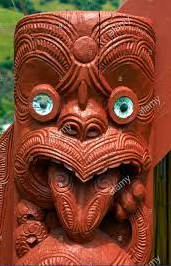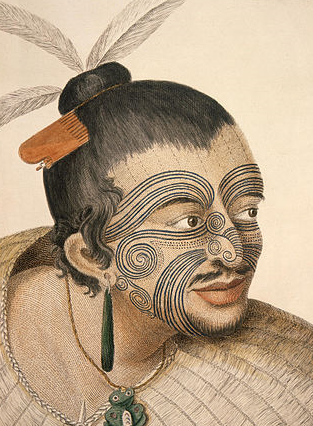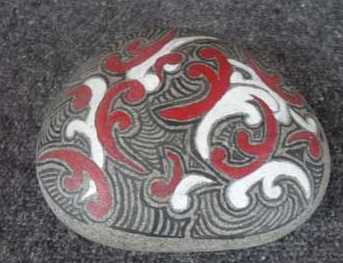Maori People are the native Polynesian culture of continental New Zealand. The Maori People originated from East Polynesia with settlers, arriving in mainland New Zealand through several waves by voyages (in canoes) between the 1320s and 1350s. With many centuries existing in isolation, the settling immigrants developed a distinct cultural identity, whose etymological, mythology, performing and visual arts, and crafts evolved independently compared to former Polynesian cultures in East Asia (where they migrated from) (Lilley, 2019). Some of the early Maori arrivals in New Zealand settled in the Chatham Islands, where their progenies became the Moriori, the other native Polynesian ethnic culture of New Zealand. Early contact between Maori indigenous people and Europeans, beginning in the eighteenth century, was characterized by various activities ranging from violent wars to beneficial trade; Maori culture actively embraced many new technologies from these contact with Europeans (Holmes, 2018).
With the signing of the 1840 Waitangi Treaty, the European and Maori cultures concurred for several generations before conflict broke out. Increasing tensions because of land disputes resulted in conflicts during the 1850s, and extensive land confiscation, to which the Maori people responded with vicious war confrontation. Following the declaration of the non-abidance to the 1877 Treaty, the Maori people in New Zealand were influenced to assimilate their culture with other key features of Western culture and civilizations (Lilley, 2019). Social epidemics and upheavals resulted in illnesses that had a devastating impact on the Maori population, with a dramatic fall in population numbers. The inauguration of the twentieth era saw the population of Maori people begins to recover following efforts made focusing on the Waitangi Treaty to enhance their political influence in broader New Zealand society and ensure social justice.
Traditional indigenous Maori people have thus enjoyed a noteworthy revitalization, which has further been bolstered by different Maori awareness movements that emerged during the 1960s different cultural independence and recognition periods (Holmes, 2018). Nonetheless, disproportionate population numbers of Maori populations face significant social and economic problems and experience lower life expectancy and income levels compared to other New
The traditional history of the New Zealand Maori people describes their origin with regards to their waves of migrating that resulted in their arrival and settlement of their great fleet from Hawaiki in the fourteenth century, a fabulous terrestrial commonly denoted as Tahiti. The historical description offers the foundation for traditional Maori social culture structure. It has been reinforced by various archaeological findings, which illuminate them as arriving in New Zealand during the 1300s (Holmes, 2018). The most commonly identified Maori cultural group is the hapu culture (the main sub-tribe), which denoted the main land-holding cultural group in which matrimonial association was favored.
The Maori culture’s visual arts consist mainly of 4 primary forms: painting, weaving, tattooing (ta moko), and carvings. These visual forms of art were rarely utilized for purely decorative intentions; traditional Maori visual art intentions were highly spiritually motivated and, during the pre – European contact era were utilized by the Maori culture to convey information concerning ancestry, spiritual issues, and other ethnically important subjects (Neha et al., 2020). The construction of visual artifacts was overseen by the tapu regulations with visual artistic styles varying between different regions developing independently: the styles now from time to time perceived as ‘norm of Maori culture’ in fact originate from the TeArawa branch, who preserve a strong continuity in how they practice their visual artistic traditions owing to their early engagements with expressing their traditions to tourists (Lilley, 2019). Most traditional Maori visual art pieces were highly stylized, featuring motifs like the koru, the chevron, and the spiral to express their Oral Legends, Poetry, and Other Literary information to other generations.
The Maori people of New Zealand employed songs, dance, chants, and poetry to express their oral legends, poetry, and other literary information to other generations. Maori cultural performance of poetry (poetry), chants (tauparapara), dance (haka), and songs (waiata) are employed by the Maori culture to pass and express understanding and knowledge relating to their communities, history, and relationships. For instance, the Haka Kapa denotes a Maori dance performance that began in 1880 as visual performance art to tourists (Neha et al., 2020). Some sets extend past New Zealand borders to perform the art. Kapa Haka dance performances as visual art were utilized during World War as an entertainment art to raise funds for Māori warriors participating in the war.
The Maori people of New Zealand employed carvings to express their oral legends, poetry, and other literary information to other generations. Carvings were undertaken in three media forms: stone, bone, and wood (Lilley, 2019). Carvings of wood artifacts were used in decoration of objects, taiaha, containers, and fence poles bearing information of poems, legends, and myths of a particular community. The most common type of wood and ornament carving was pounamu carving, a soft wood carving, but other types of material carvings were also employed, particularly in other mainland regions where pounamu art was not extensively practical (Neha et al., 2020). With European contact, carvings of Maori culture evolved to be more intricate, expressing more detailed oral literature, poems, and art information through decorative approaches.

The Maori people of New Zealand employed Ta moko, a traditional Maori tattooing carving, in expressing their oral legends, poetry, and other literary information to other generations. Ta moko is undertaken using a chisel bearing poetic or religious significance (Holmes, 2018). Men are tattooed extensively on their bodies compared to women: women are tattooed on their chin and lips, with men bearing tattoos on parts such as thighs, and faces. In large part, Ta moko tattoos convey an individual’s ancestry (Holmes, 2018). Even though modern Tamoko reflects traditional attitudes, the process is undertaken by modern tattooing equipment.

The Maori people of New Zealand employed painting and weaving in expressing their oral legends, poetry, and other literary information to other generations. Even though the oldest visual types of Maori art pieces are visible stone paintings, painting does not stand out as central in’ classical’ Maori arts. The painting was majorly utilized as a decorative approach in house aesthetics to tell stories or reflect position (Lilley, 2019). The contact with European culture allowed Maori paintings to become more intricate in depicting Maori oral legends in rocks, with different colors applied to reflect more intricate details of tales encompassed. The process of weaving was majorly done by women producing artifacts that reflected a particular view point of the culture.

References
Discover Māori culture in New Zealand | 100% Pure New Zealand. Web.
Neha, T., Reese, E., Schaughency, E., & Taumoepeau, M. (2020). The role of whānau (New Zealand Māori families) for Māori children’s early learning. Developmental Psychology, 56(8), 1518. Web.
Holmes, J. (2018). Negotiating the culture order in New Zealand workplaces. Language in Society, 47(1), 33-56. Web.
Lilley, S. (2019). Developing Māori collections. Collection and Curation. Web.